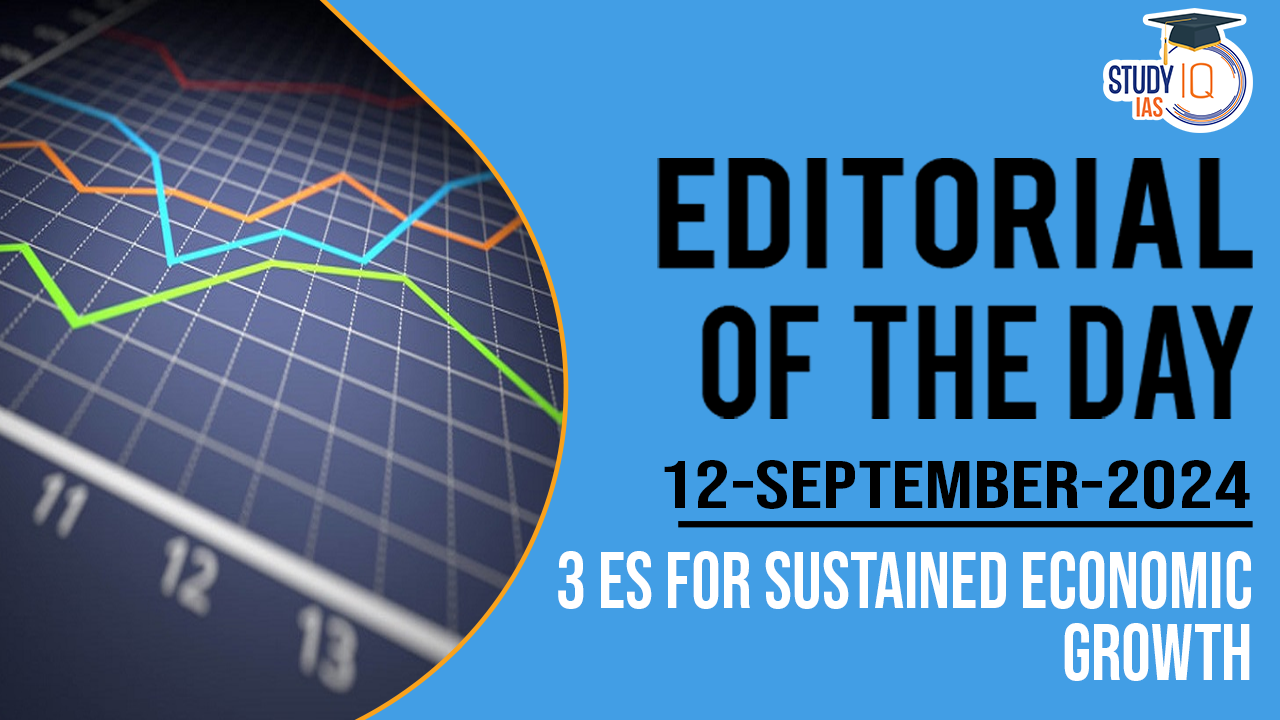Table of Contents
What does Economic Growth Means?
Economic growth is defined as the sustained increase in a country’s real national income and per capita income over an extended period of time.
- The increase in Per-Capita income is the better measure of Economic Growth since it reflects an increase in the improvement of living standards of the masses.
Current Economic Status
- India’s nominal GDP is projected to reach $3.9 trillion in 2024.
- Historical GDP Growth:
- Took 60 years post-independence to reach the first trillion dollars.
- The second trillion achieved in seven years, and the third in five years (2019).
- Surpassed the UK in 2022, becoming the fifth-largest global economy.
What is the difference between Economic Growth And Economic development?
| Feature | Economic Growth | Economic Development |
| Meaning | Increase in real output of goods and services | Progressive changes in income, savings, investment, and socio-economic structure |
| Factors | Growth in consumption, government spending, investment, net exports | Growth in human capital, decrease in inequality, and structural changes improving quality of life |
| Measurement | Quantitative factors like real GDP or per capita income | Qualitative measures like HDI, gender-related index, HPI, infant mortality, literacy rate |
| Effect | Quantitative changes in the economy | Qualitative and quantitative changes in the economy |
| Relevance | Reflects growth of national or per capita income | Reflects progress in quality of life |
Current Three Key Drivers of Indian Economic Growth
- UPI Rollout: The government’s introduction and expansion of UPI made digital payments accessible to millions of people.
- By May 2023, UPI had processed 9.41 billion transactions worth INR 14.89 lakh crore (approximately $181 billion) in just one month.
- Telecom Revolution: The telecom industry, with affordable data and internet access, transformed connectivity for millions.
- The Indian telecom sector is the second largest in the world, with over 1.2 billion subscribers as of FY24.
- Pandemic’s Boost to E-commerce and Startups: The COVID-19 pandemic accelerated growth in e-commerce and startups, further contributing to the economy.
- The number of online shoppers increased significantly, with the e-commerce market expected to grow to over $300 billion by 2030.
- India has the third-largest startup ecosystem, with over 4 lakh DPIIT-registered startups.
-
- It generates one unicorn every 20 days on average over the last 7-8 years.
- Startups and corporate counterparts injected $140 billion into the Indian economy in FY23 (~4% of GDP).
|
Facts |
Factors Driving Startup Growth
|
What are the needs?
- Sustained Economic Growth: India has experienced significant economic growth, fueled by digital innovations and the startup ecosystem, which needs to be maintained and amplified.
- Skilled Workforce Development: The rise of Industry 5.0 technologies like AI and Machine Learning necessitates a workforce equipped with advanced technical skills.
- Enhanced Entrepreneurship: There’s a need to foster a culture of entrepreneurship among the youth to keep pace with global trends and to fuel job creation.
Challenges
- Educational System Limitations: Current higher education institutions may not adequately prepare students for entrepreneurial roles or jobs in new technology sectors.
- Inadequate R&D Investment: At just 0.7% of GDP, India’s investment in research and development is considerably lower than leading economies, limiting innovation potential.
- Job Creation Gap: There’s a potential gap in the rate of job creation compared to the number of graduates entering the workforce, exacerbated by automation and new technologies.
- Regional Economic Disparities: There is a noticeable disparity in economic development and opportunities between different regions of India.
Recommendations
- Integration of Education, Entrepreneurship, and Employment (3Es): Proposing the integration of these three critical sectors to stimulate sustainable economic growth.
- Rethink success metrics of Higher Education Institutions (HEIs) to include the creation of entrepreneurial ventures.
- Strengthen academia-industry linkages to support and fund research ideas into successful ventures.
- US Academic Tech Transfer: Contributed over $1 trillion to industry output over 20 years, showcasing the benefits of robust academia-industry relationships.
- Increasing R&D Spending: Advocating for increased expenditure in research and development, particularly within higher education institutions, to support cutting-edge research and development.
- Promoting Entrepreneurial Mindset: Encouraging more students to consider entrepreneurship as a viable career option, potentially transforming the economic landscape by significantly increasing the number of new entrepreneurs and startups annually.
- Systematic Support for Startups: Recommending systematic support for nurturing, supporting, mentoring, and funding research ideas and startups from the graduate level upwards.
Conclusion
India’s future growth depends on leveraging its youthful workforce, fostering innovation and entrepreneurship, and building a strong academia-industry linkage to drive economic progress during the Amrit Kaal (2047).


 Places in News for UPSC 2025 for Prelims...
Places in News for UPSC 2025 for Prelims...
 New Phase of Operation Chakra to Combat ...
New Phase of Operation Chakra to Combat ...
 Soyuz Aircraft: History, Design and Sign...
Soyuz Aircraft: History, Design and Sign...





















